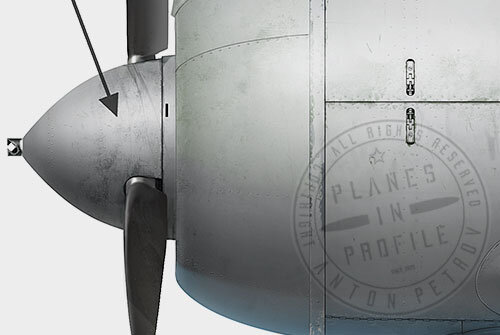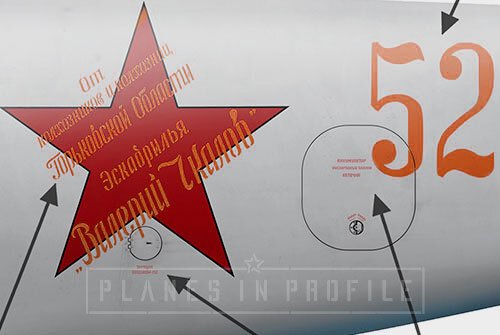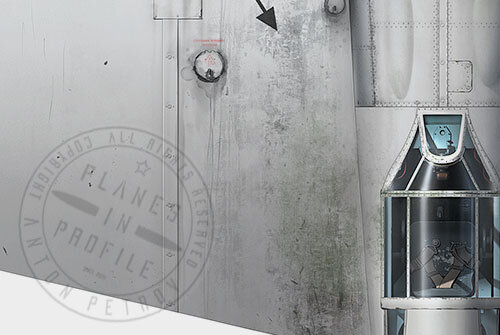(Scarlet?)-52
LAVOCHKIN, LA-5 (TYPE 37)
193-th IAP, 302-nd IAD, 4-th IAK, Rezerv Stavki VKG, circa February 1943, (Possibly) airfield of the 2-nd ZIAP MVO in Seyma, Gorkiy (Today’s Nizhniy Novgorod) region.
Flown by an unknown pilot.
After battle action which included the storming of the roads south of Kalinin in 1941, providing cover to the Soviet ground forces in the Makarovo-Chertolino and Staritsa regions in March 1942, and action in Tavrovo (Kalinin region) ‘till August 1942, 193-rd IAP was withdrawn from the front in order to recuperate.
From the 27th of August 1942 to 10th of March 1943, while withdrawn from active army, the 193-rd IAP was undergoing restructuring, with its pilots and technicians being retrained to fly and to service the latest Soviet fighter - the La-5, at the 2-nd ZIAP’s base in Seyma, near Gorkiy. [4] The only photo of (Scarlet?)-52 which could be found, was most probably taken there, in February 1943.
Gorkiy was home to factory number 21 which produced most of the La-5 airplanes. Out of 1021 La-5 airplanes (type 37- the ones with a ‘high back’ ) which were produced in total, 999 were produced at this factory (the other 22 were produced at factory number 31 in Tbilisi, Georgia.) [5]. The city’s region was also the birthplace of Valery Chkalov and the location of the collective farms which raised the funds for the building of the ‘Eskadrilya Valeriy Chkalov’ (E.V.Ch.) airplanes, close to 200 [2] of which were built in total. 193-rd IAP was the second regiment to receive some of these airplanes, getting 14 of them, including (most probably) the (Scarlet?)-52. The first 17 E.V.Ch. airplanes before that were given to the 4-th GIAP [6]. What makes (Scarlet?)-52 special is that it has a rather unusual dedication inscription design. This is perhaps the early design of the famous E.V.Ch. dedication inscription (As discussed in the ‘Noteworthy visual characteristics’ section below).
In March 1943 the renewed 193-rd regiment , armed with their new La-5 airplanes, was sent to the Voronezh front. One of its first tasks was to defend the town of Valuyki from enemy raids. Closer to summer the regiment moved towards Kursk and beyond, taking part in many battles up until July 1944. The regiment ended the war with the following stats: 10,418 battle sorties, 258 enemy planes destroyed in battle, destroying also - 17 enemy aerostats, 20 planes on the ground, 5 tanks, and numerous other ground targets, including cannons, trains, trucks, motorbikes and even one barge. [7]
The ultimate fate of (Scarlet?)-52, or the name of the pilot who flew it, is unknown.
Noteworthy Visual Characteristics
1) Often the spinners of Soviet fighters were painted with specific identification colours of their units. There is no photo reference that I could find to show what the spinner of (Scarlet?)-52 looked like, but it was most probably painted with the standard AMT-6 black as part of the Green/Black camouflage. It was then covered with the temporary white MK-7 paint as part of the standard winter camouflage. This hypothesis is based on the photos of other planes from the 193-IAP, which seem to show black spinners under the partially removed white paint.
2) The cowl flaps might have been unpainted (bare metal). This is based on the same photo reference as in point ‘1’ , as well as this photo of another plane (La-5F) from the 193 IAP.
3) The frame around the back glass panel of the canopy appears to be darker than white in the photo reference. It was most probably bare metal (unpainted)
4) The inscription written across the star reads:
Oт
колхозников и колхозниц
Горьковской Области
Эскадрилья
”Валерий Чкалов”
It translates to:
From
The collective farmers (male) and the collective farmers (female)
Of the Gorkiy oblast (region)
Eskadril’ya
“Valeriy Chkalov”
The design of this inscription on (Scarlet?)-52 is an example of the rare, most probably early, design variation of the ‘Eskadril’ya Valeriy Chkalov’ (E.V.Ch.) inscription. The (later?) inscription design which became the classic identifier of the E.V.Ch airplanes was separated into two parts, with large, horizontal Eskadril’ya “Valeriy Chkalov”appearing on the left side of the fuselage and a smaller, but still horizontal From the collective farmers (male) and the collective farmers (female) of the Gorkiy region appearing on the right side of the fuselage. White-60 is a great example of this ‘classic’ E.V.Ch. inscription design.
The E.V.Ch. inscriptions appeared on the airplanes built with the money raised and donated to the ‘Red Army war fund’ by the workers of the Gorkiy (Today’s Nizhniy Novgorod) region. Many collective farms participated in this ‘fund raiser’ and a total of about 60, 000,000 roubles was raised [1], a further 1.1 million was raised by the Fire Brigades of the Gorkiy region [1b] - astronomical amounts of money for that time. Even schools participated in the collection of funds for the E.V.Ch airplanes, and at least one airplane was known to have been built with these.
These funds were enough to build about 200 airplanes[2], mostly La-5s and some LaGG-3s, which were distributed across many different units, including the 193 IAP, as well as 11 IAP, 21 IAP, 159 IAP, 4 GIAP KBF, 5 GIAP, 41 GIAP, 111 GIAP, 180 GIAP, and 3-rd IAK. [3]
Valeriy Chkalov was a famous Soviet test pilot who died in 1938 during a test flight of a Polikarpov I-180. He was from the Nizhniy Novgorod (former Gorkiy) region, which is why the farmers chose to name the ‘Eskadrilya’ after him.
Massimo Tessitori did some good research on the ‘Eskadrilya Valeriy Chkalov’ and it’s worth visiting his website HERE to learn more about it.
5) The colour of the tactical number ‘52’ (and the E.V.Ch. inscription) is a topic that raises a lot of questions.
Unfortunately, It doesn't seem like anyone can confirm what the true colour of '52' was. It is clearly lighter than the red of the star in the photograph http://www.airforce.ru/content/attachments/60168d1418465729-215iad.jpg
This "lightness" is what led me to make the number yellow initially, but yellow is not an easy colour to see on a white background and yellow was a 'rare' colour in the USSR during the war, as some have pointed out since then. It's been suggested that the colour should be red, though that doesn't seem right to me.
I ended up darkening the colour and bringing it closer to red, essentially making it scarlet/"flame" coloured, it's a colour that is hypothetical still, but it's not any more hypothetical than yellow was I guess. According to some, the Soviets did occasionally use red that was close to orange, as for example the colour that has been suggested to me for the markings on 'White-70’ La-5FN "Mongolskiy Art".
Initially I drew this airplane with a yellow tactical number and inscription, but ‘yellow’ is a difficult colour to see on a white background, so it’s unlikely that the colour was yellow.
6) The technical markings are faintly visible on top of the MK-7 paint. These might have been painted with red paint, or some other light colour.
7) The airplane is covered with MK-7 temporary white paint. This paint was designed to be indistinguishable from snow visually and in the ultraviolet spectrum. The paint was created by mixing chalk (diluted with water and alcohol) and casein glue. 0.1-0.2% of ultramarine colour was added to this mixture to remove the ‘yellowness’. This mixture was designed to slowly come off the airplane throughout spring, giving the airplane camouflage it’s patchy ‘spring distemper’ appearance, completely coming off and revealing the Green/Black camouflage underneath it by summer time.
The photo reference of Scarlet-52 shows it to be quite evenly covered with MK-7, which means that the plane must have still been relatively ‘new’ at the time the photo was taken. The only areas where the paint might have started to come off would have been the parts which were handled or walked on the most, such as the wing roots indicated by number ‘8’.
Here are a few close-up images to help illustrate the points above. Full set of close-up images is On Patreon
FOOTNOTES
[1] Based on Stalin’s telegram :
’Please convey my brotherly greetings and gratitude to the collective farmers of the Gorky Region, who have raised 60 million rubles for the Red Army fund to organize the Valery Chkalov combat aircraft squadrons. I. Stalin "
The quote was found here: http://www.chkalovsk-zbs.narod.ru/bibl/75let/Aviaeskadriliya.html
[1b] The sum collected by the firemen is according to the contents of a telegram from Stalin, as described in an image from the National Archive of the Gorkiy Region.
[2] The number of planes is based on the information on page 79 of Miloš Veštšik’s book called ‘Lavockin La-5’, published by MBI in 2006.
[3] The list of regiments which received the Valeriy Chkalov airplanes was taken from the ‘Soviet aerial tactical markings of WWII’ website page. http://www.wio.ru/simbols/sov-en.htm
[4] The info is based on the Russian Wikipedia article about 193-rd IAP
[5] The number of La-5s built is taken from the book called ‘Lavočkin La-5’ by Miloš Veštšik, page 39. Published by MBI in 2006.
[6] The number of airplanes that 193-rd IAP received is taken from page 12 of Modelist Konstruktor’s ‘Aviakollektsiya’ magazine , ‘Lavochkin La-5’, Part2. Published in 2008.
[7] The stats are based on the information found on ava.org.ru http://ava.org.ru/iap/177g.htm
Summary of LINKS TO THE REFERENCE IMAGES AND VIDEOS
http://www.airforce.ru/content/attachments/60168d1418465729-215iad.jpg
All the work presented on this is page is subject to updates and revisions in the light of new information which might present itself. If you have any new information relevant to this page or disagree with anything that's presented here, then please feel free to contact me through the Planes in Profile Facebook page. Thanks:)






